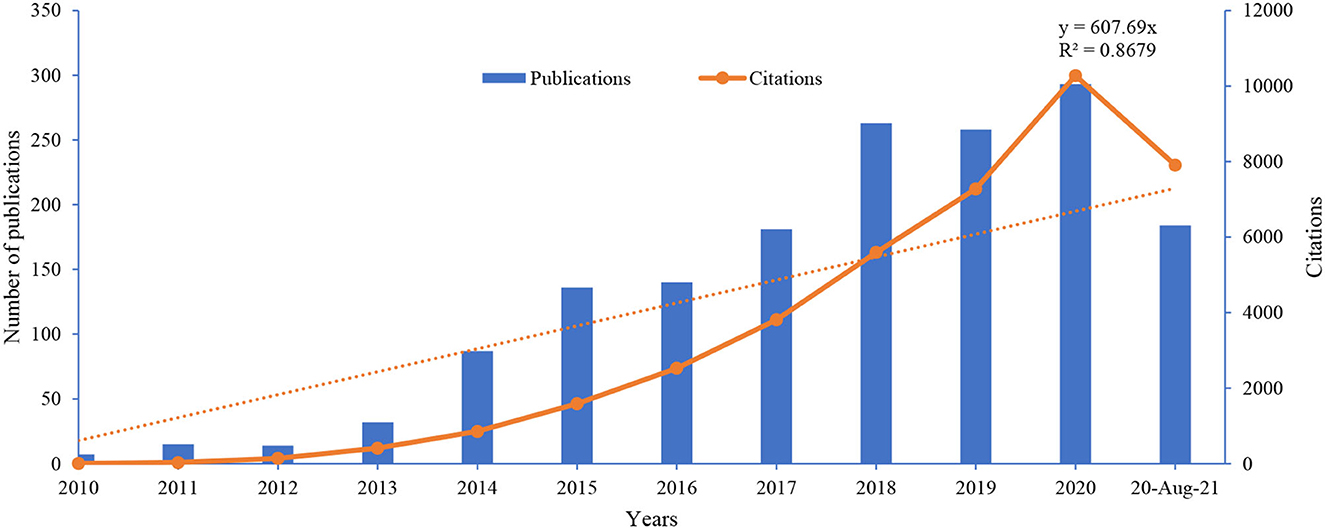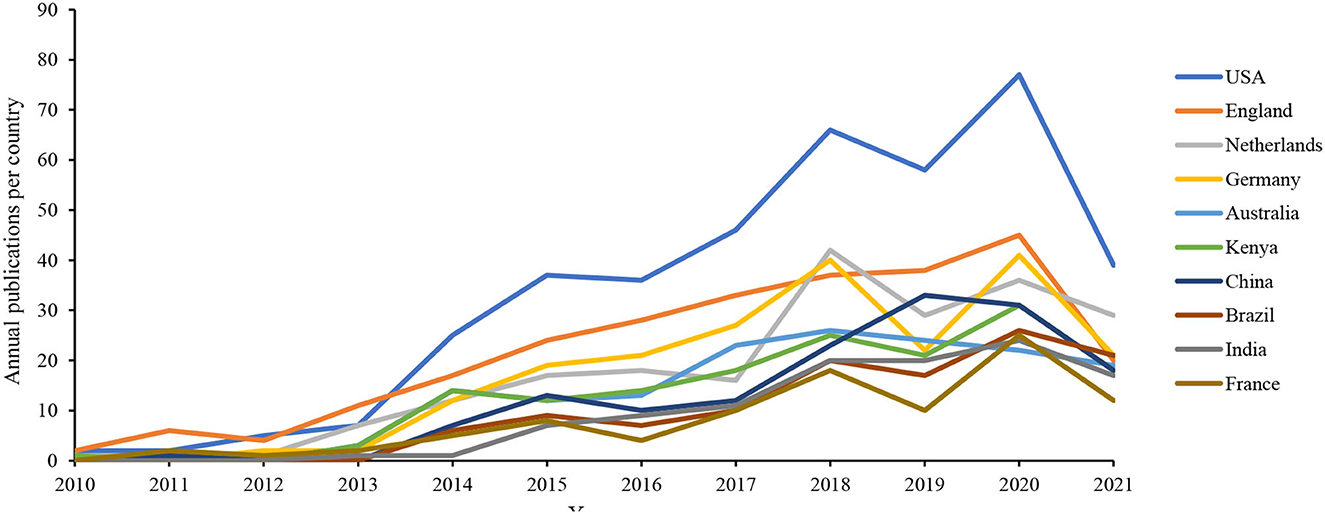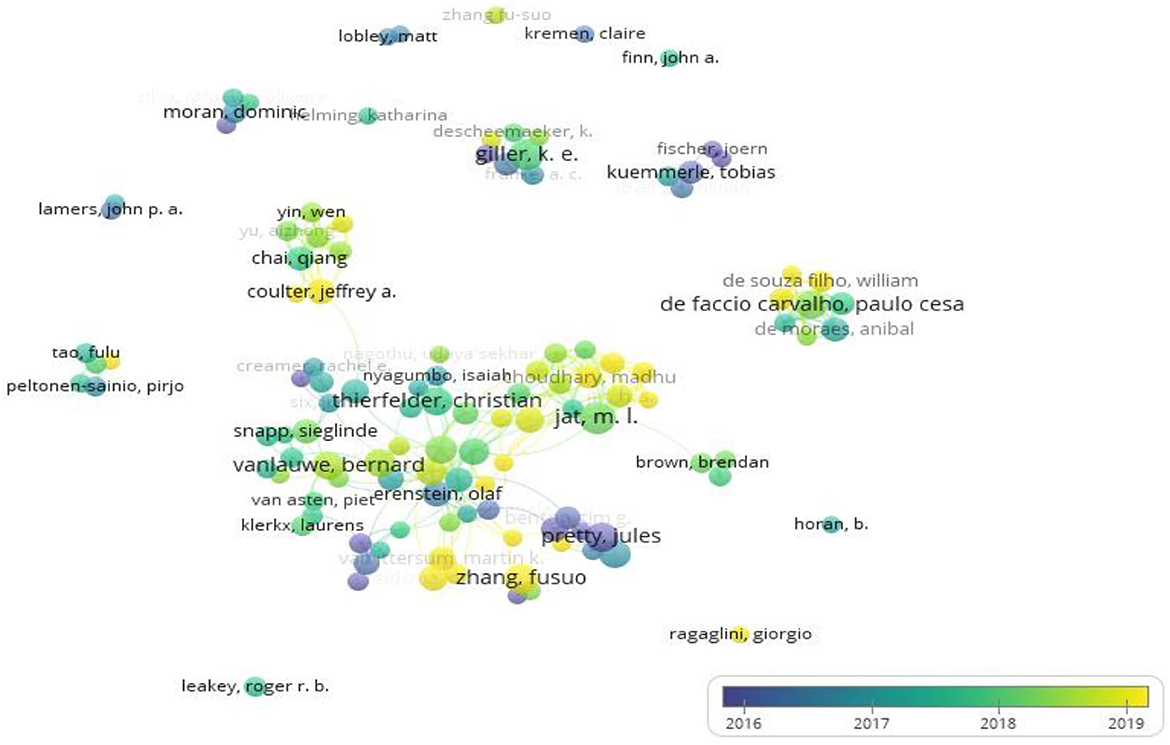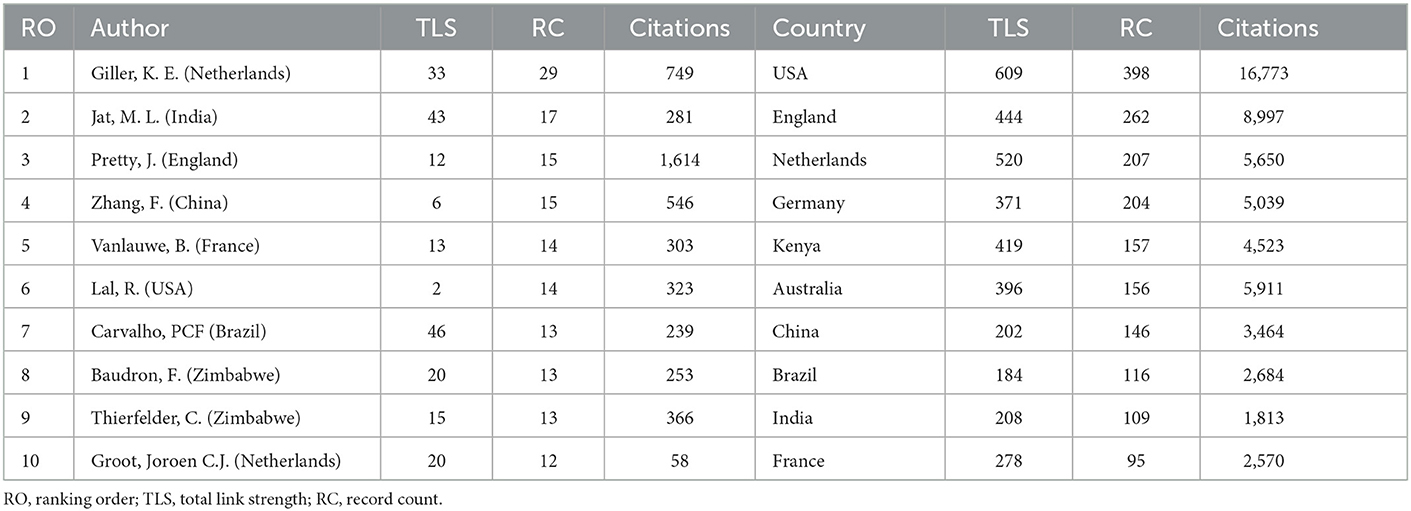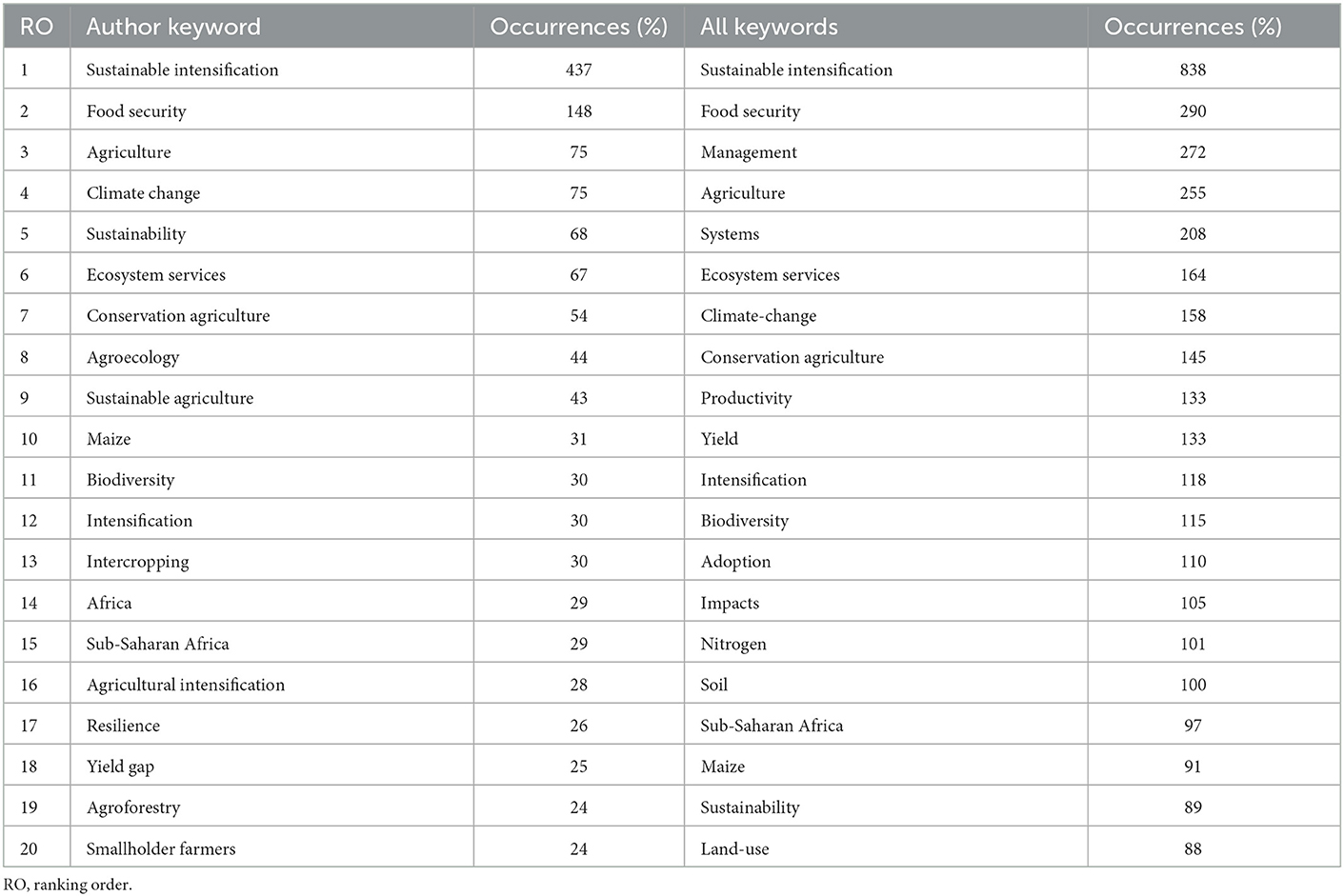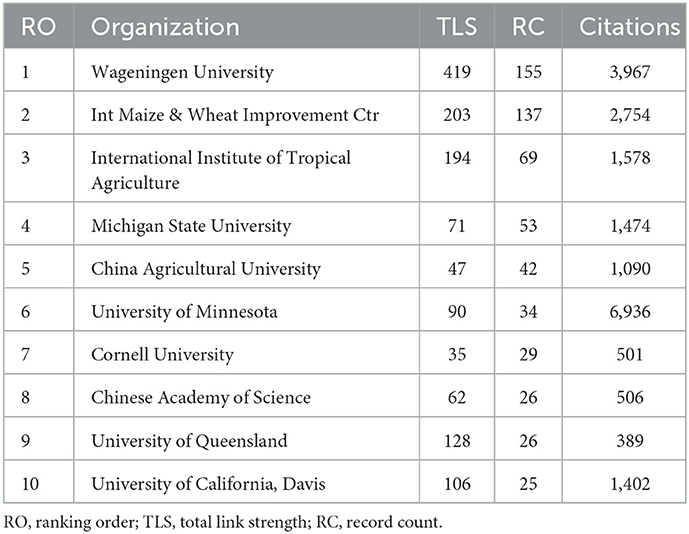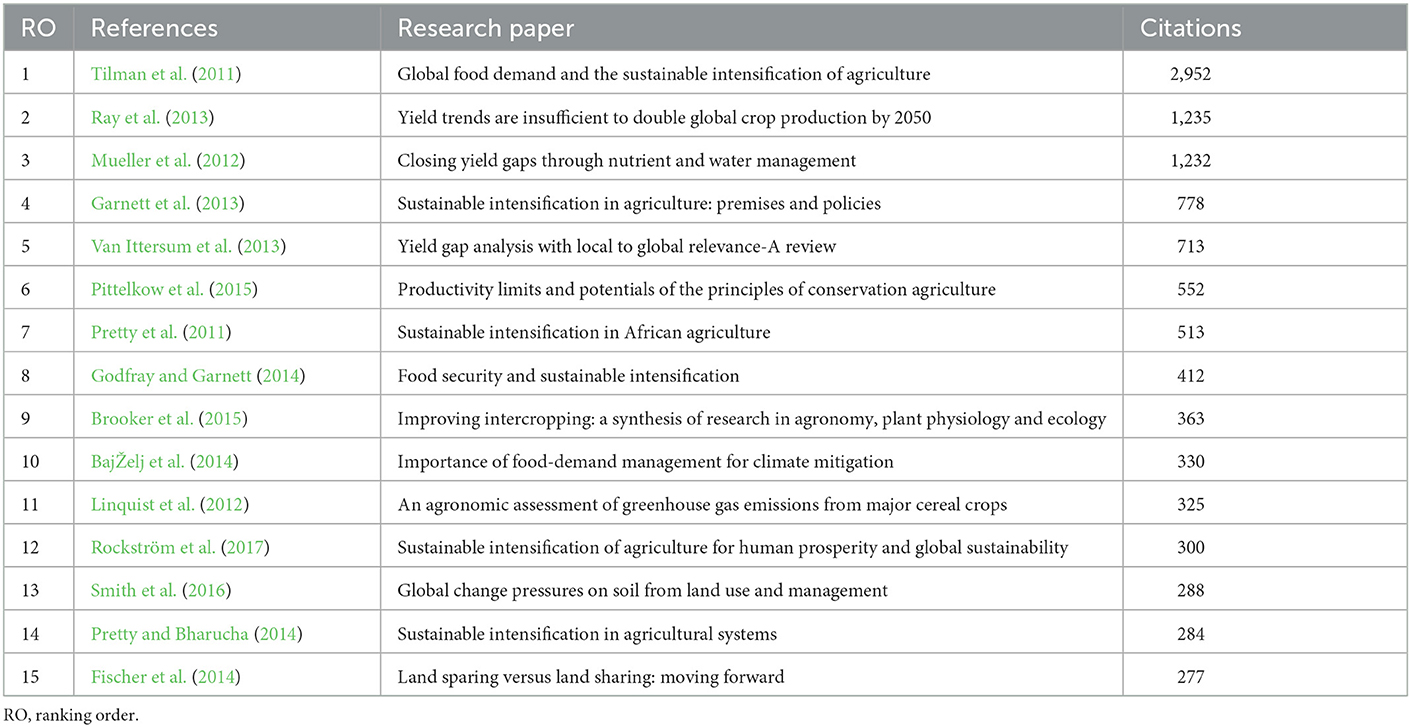- 1Department of Soil Science, Institute of Environmental Sciences, Hungarian University of Agriculture and Life Sciences, Gödöllo, Hungary
- 2AKI Institute of Agricultural Economics and Corvinus University of Budapest, Budapest, Hungary
Sustainable intensification (SI) of agriculture is required to satisfy the growing populations' nutritional needs, and therefore food security while limiting negative environmental impacts. The study aims to investigate the global scientific output of sustainable intensification research from 2010 to 20 August 2021. The data was retrieved from the Web of Science (WoS) Core Collection and was analyzed using a bibliometric method and VOS viewer to determine the most productive countries and organizations by collaboration analysis, including the keywords to analyze the research hotspots and trends, and the most cited publications in the field. From the 1,610 studies published in the theme of sustainable agriculture by 6,346 authors belonging to 1,981 organizations and 115 countries, the study found an increased number of publications and citations in 2020, with 293 publications and 10,275 citations. The United States ranked highest in countries collaborating with the most publications in the field. The occurrence of keywords like “food security”, “climate change”, “agriculture”, “ecosystem services”, “conservation agriculture”, “Sub-Sahara Africa”, “Africa”, “biodiversity”, and “maize” in both author and all keywords (author and index) reveal the significance of sustainable intensification in Africa, as a solution to food insecurity under climate change conditions. The availability of funding agencies from big economies explains the growing interest by developing countries in the SI of agriculture research due to the growing population, food insecurity, and access to limited land for farming.
1. Introduction
Soil has become one of the world's most vulnerable resources due to climate change, land degradation, and biodiversity loss. The expansion of arable land is associated with ecological and social costs, and hence, avoiding the conversion of natural land to arable land is beneficial for biodiversity (Phalan et al., 2011) and other important ecosystem services (Garnett et al., 2013). For enhanced management of natural resources with attention to minimizing trade-offs between profitability and productivity, sustainable intensification (SI) approaches have been promoted (Garnett et al., 2013; Kaczan et al., 2013; Pretty and Bharucha, 2014). Based on Godfray et al. (2010), Pretty et al. (2011), and Giller et al. (2015), important features of SI include the production of more output per unit area, increasing the flow of environmental services, and the accumulation of natural, social, and human capital. Based on Pretty (1997), and Garnett and Godfray (2012) SI was initially used in the mid-1990s in smallholder African agriculture. It was also highlighted by Kassie et al. (2015) and David et al. (2016), that global research on SI practices is mainly concentrated in Africa where farmers are the main research object, including their behavior choices in the practice of SI. In Africa, SI is important since it provides possibilities for increased crop production per unit area while addressing features of sustainability such as social, economic, political, and environmental impacts (FAO, 2006). Sustainable intensification (SI) is more extensively used (Tittonell, 2014; Petersen and Snapp, 2015) than ecological and agroecological intensification, and to meet the current food security demand, SI has received much prominence as a key approach (Smith et al., 2017). Evidence has increasingly shown that sustainable agricultural practices have the potential to meet sustainability and boost agricultural productivity (Rockström et al., 2017). However, based on the same author, production increases don't necessarily mean that yields should increase at any cost or everywhere as yield increase in some areas is compatible with environmental improvements, while in others, land reallocation and reductions in yield is required to ensure sustainability and to deliver environmental benefits like carbon storage, recreation, biodiversity conservation, and flood protection. The global challenges of food security require global responses, and the fundamental problems of food security are addressed with several mechanisms such as SI of agriculture and the United Nations Sustainable Development Goal goal to end hunger. The goal to fight climate change and end food insecurity is clearly specified under goal 2 of the SDGs, which is to “end hunger, improve nutrition, achieve food security and promote sustainable agriculture.” Nevertheless, without arable land, soil remediation, or reclamation, it would be difficult to achieve this goal. Hence, mapping of research trends and existing knowledge trajectories are important in order to hypothesize and reach a conclusive solution toward SI of agriculture. Due to the lack of food security in the various parts of the globe, SI can play a significant role in bridging the food insecurity confronting the agricultural sector, only if the knowledge of current research trajectories is understood. One of the means to underscore what has been done, and what gaps remain and to understand present research focus, is conducting bibliometric mapping. It is important to dissect and conduct knowledge mapping through bibliometric analysis. One of the significances of this study is to highlight the knowledge gaps and how SI could be utilized as remediation process. For example, in 2015, Okem observed that despite the achievements of the Comprehensive African Agricultural Development Programme (CAADP), food security in Africa continues to be a persistent problem (Okem, 2015). Even recently, the food insecurity problem still persists (Ajibade, 2020; Ngcamu and Chari, 2020; Ojo et al., 2022). Furthermore, a recent study conducted in Canada highlighted that food insecurity is still a prevailing challenge in Canadian household (Hutchinson and Tarasuk, 2022). It is therefore, imperative to understand whether debates about food insecurity, and SI understood the inseparability of these two concepts.
To highlight the global research trends in the field of sustainable intensification (SI) of agriculture, a bibliometric analysis was used based on publications retrieved from the Web of Science (WoS) Core Collection database between 2010 and 2021 while Vosviewer software was used to visualize pertinent results. Bibliometric analysis has been used in various fields, and as an important quantitative analysis tool, as it can effectively describe the overall trend of subject or field development (Hirsch, 2005; De Bakker et al., 2016). Based on the main research findings, key research areas concerning sustainable agricultural intensification that need improvement in the future are explored.
1.1. Literature search
Due to the rapidly growing global population, sustainable intensification (SI) of agriculture has gained more attention, especially in Sub-Saharan Africa where the population is rapidly increasing (Bello-Schünemann et al., 2017), together with a high increase in soil degradation (Tully et al., 2015), that is aggravated by climate change (IPCC, 2007). Also, with ~40% of the world's terrestrial surface being transformed to agriculture (Ramankutty et al., 2008), in 2018, only 9% of the world's agricultural land had undergone SI (Pretty et al., 2018).
Agricultural technologies usually promoted as supporting pathways to sustainable intensification (SI) include Climate Smart Agriculture (CSA) and Conservation Agriculture (CA), and Integrated Soil Fertility Management (ISFM) (Place et al., 2003; Giller et al., 2015), including agroforestry, carbon benefits, integrated pest management, and ecosystem services (Mbow et al., 2019). Based on Mbow et al. (2019) and Xie et al. (2019), numerous SI practices can be grouped into 10 approaches and categories depending on their application as explained in the review study of Nciizah et al. (2022). The approaches mentioned in their study, include irrigation water management, soil management, increased agricultural system diversity, and integrated pest management among others. These approaches have the potential to improve food security. For instance, in Savannah regions, the Comprehensive Assessment of Water Management in Agriculture (2007), showed a large potential in upgrading rainfed agriculture by improving rainwater harvesting. For example, in semi-arid areas of Burkini Faso where smallholder farmers are using planting pits to rehabilitate degraded land and harvest rainwater for sorghum and millet cultivation, 300,000 hectares of land have been rehabilitated, with an annual increase of 80,000 tons of food produced (Reij et al., 2009). Rusinamhodzi et al. (2011) reported significant yield gains for smallholder farmers who adopted conservation agriculture in several parts of Sub-Saharan Africa. For example, in Mozambique yield increases of up to 27% were reported by Thierfelder and Wall (2012), and these production increases were associated with increased soil organic carbon, which improved biological and physical soil processes. It is worth noting that, the benefits of adopting SI practices have been reported in other countries as well. For example, in Brazil, it was reported by Altieri et al. (2012) that producers who adopted conservation agriculture under severe drought conditions from 2008 to 2009, experienced smaller maize yield losses of around 20% on average, compared to 50% experienced by conventional maize producers.
However, through the lens of climate change, climate-smart agriculture (CSA) aims at achieving the same objectives of food security as sustainable agriculture. In Africa, CSA can increase productivity and resilience while reducing the vulnerability of millions of smallholder farmers (Sullivan et al., 2012). Climate-smart agriculture (CSA) is based on CA, agroecology, and organic farming [Department of Agriculture, Forestry and Fisheries (DAFF), 2014], in countries like South Africa. CSA and agroecological agriculture share their objectives of food security and climate change. Agroecology is presented by the Global Alliance for Climate-Smart Agriculture (GACSA) (2014), as a component of CSA and SI, but CSA and agroecology are different in other aspects. CSA desegregates three dimensions of sustainable development (i.e. economic, social, and environmental) by addressing climate change and food security. There are, however, some disputes about the kind of practices and technologies which should be considered in CSA. It was interesting to find that researchers like Campbell et al. (2014) consider CSA as complementary to SI of the agricultural production system. Their views agree with Garnett and Godfray (2012), who noted that using sustainable agricultural intensification increased crop yields without harmful environmental impacts and cultivation of more agricultural land. CSA is comprised of three pillars: sustainable development, SI and green economy, and its connection with conservation agriculture-based SI, organic farming, CSA, and food security (Figure 1).
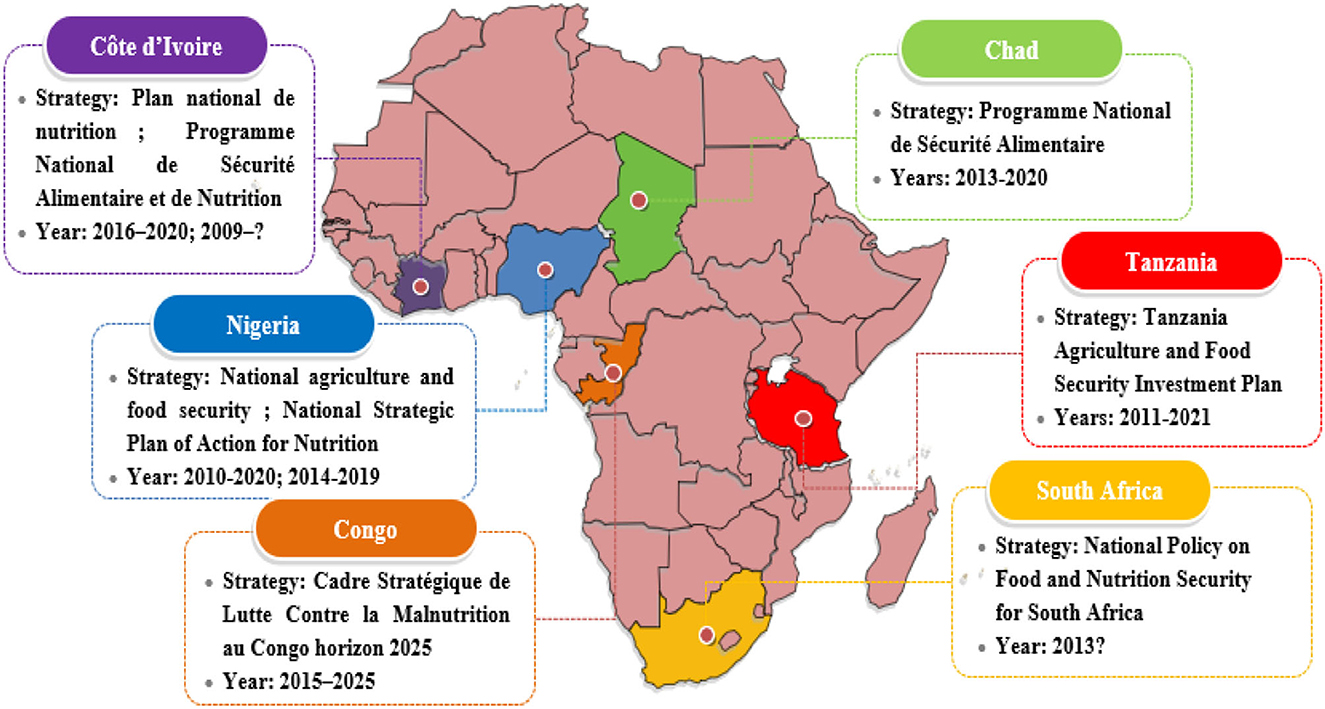
Figure 1. Integrated food and/or nutrition security strategies in selected countries of Sub-Saharan Africa.
Recent study indicated that in many countries where food insecurity is a challenge, governments have developed or are in progress of developing integrated food and/or nutrition security strategies (IFSSs; Figure 2) (Ajibade, 2020). These strategies are explicit governmental attempts to fundamentally redesign or align goals, instruments, and capacities to achieve the four basic dimensions of food security (Rayner and Howlett, 2009) such as food availability, access, utilization, and stability. For instance in South Africa, the approval of the National Policy for Food and Nutrition Security Strategy in 2013 indicated the recognition by the government of the need for a coordinated approach to addressing food security (Nkwana, 2015). The policy acknowledges the complex nature of food security and aims to provide a framework for synergy between the various programs and policies in place.
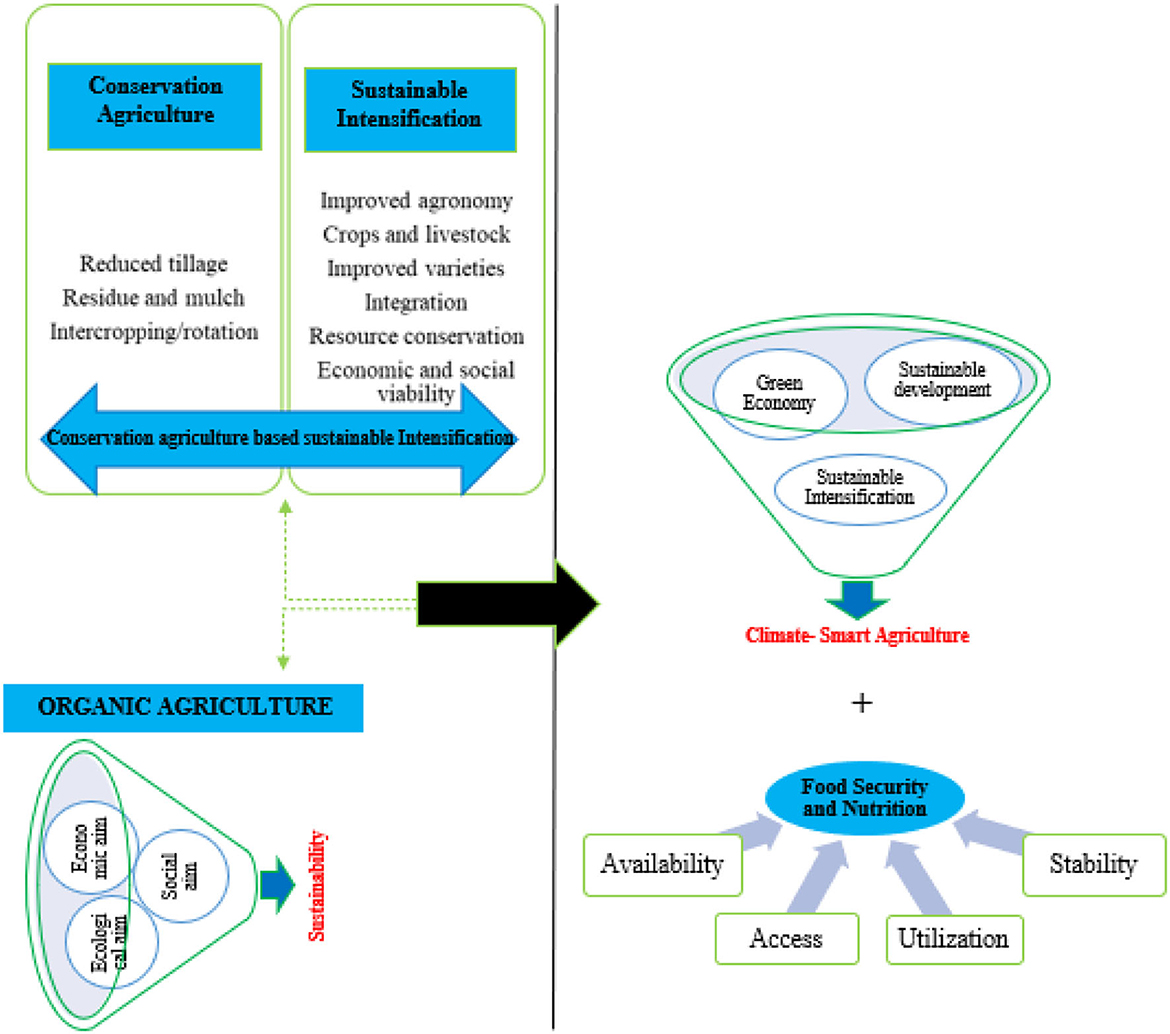
Figure 2. The connection between sustainable intensification, innovative agricultural practices, and food security and nutrition.
2. Materials and methods
2.1. Data collection
The data were retrieved on the 20th of August 2021. The relevant literature used in the present study was collected from the Science Citation Index Expanded (SCI-E), Social Science Citation Index (SSCI), Conference Proceedings Citation Index-Science (CPCI-S), Book Citation Index-Science (BKCI-S), and Emerging Sources Citation Index (ESCI) in the Web of Science (WoS) Core Collection. In bibliometric studies, the SCI-E is the frequently used database in the WoS Core Collection (Yu and Liao, 2016; Shi et al., 2019) and is also the most reputational academic journal system where published papers are ensured with a rigorous peer-review process (Wang and Wang, 2019; Li et al., 2020). WoS covers a wide range of research papers from different fields, and this includes over 50,000,000 classified research papers, 15,000 journals in 150 research areas and 251 categories (Merigó and Yang, 2017). WoS has the highest quality (Mora et al., 2017) and covers many research papers from different fields. The search terms were “sustainable intensification” OR “Sustainable Agricultural Intensification” OR “Sustainable Intensification of Agriculture” OR “Agricultural Sustainable Intensification,” and these terms appeared in the title, abstract, author keywords, and keywords plus to ensure relevant literature. The time range was set from 2010 to 20 August 2021, and 1,610 research papers were obtained.
2.2. Methodology and analysis tools
The review of the literature in the study was done through a bibliometric analysis. Bibliometric analysis is widely used in hotspot research (Yeung et al., 2017) and the development of the whole subject field (Merigó and Yang, 2017). Based on Zou et al. (2018), the method uses quantitative analysis and statistics to investigate the development of the research field and knowledge structure. Also, by bibliometric analysis it is possible to construct a network based on the co-authorship or relationship between countries, organizations, journals, and authors (Sweileh et al., 2016), including keywords about the field (Chen et al., 2016). The keyword co-occurrence network [author and all keywords (author and index)], co-authorship, overlay and density visualization were obtained using the VOSviewer technique based on Van Eck and Waltman (2010) VOS algorithm. Based on Nobanee et al. (2021), the technique efficiently combines literature and from the retrieved publications establishes similarities and important themes among the publications.
It is worth noting that the basic color view of a topic in VOSviewer depends on the ordinary density rule. Therefore, in the visualization map, color of a point is determined by the item density of the point. The average distance between two items is denoted by as shown in equation 1:
Then, the item density D (x) of a point x= (x1, x2) is defined by equation 2.
where k: [0, ∞) → [0, ∞) denotes a kernel function; wi weight of item i, which is the total number of occurrences of item i, while h > 0 denotes the kernel width, with the kernel function k as a non-increasing parameter. VOSviewer uses the Gaussian function shown in Equation 3 below.
The function in Equation 3 follows from Equation 2 that the item density (D(x)) of a point in the visualization map depends on the number of neighboring items and weights of the items. Therefore, the higher the number of neighboring items and the smaller the distances between these items and the point of interest, the higher the D(x) will be. In addition, the higher the weights of the neighboring items are, the higher the item density will be (Xia and Zhong, 2021).
3. Results
3.1. Document types
The number of publications was associated with Sustainable intensification (SI) in various document types like articles, reviews, editorial material, early access, etc. (Figure 3). The results indicate that the most frequently used category of research papers is articles, as they account for 80.44% (1295) of the total publications. The second most used communication channel category in SI is review articles, comprising 13.29% (214) of the publications. For other documents like book chapters, proceedings papers, editorial materials, early access, correction, etc., each had less than 100 publications. The least used communication approach is books, letters, and news items, contributing 0.06% of publications.
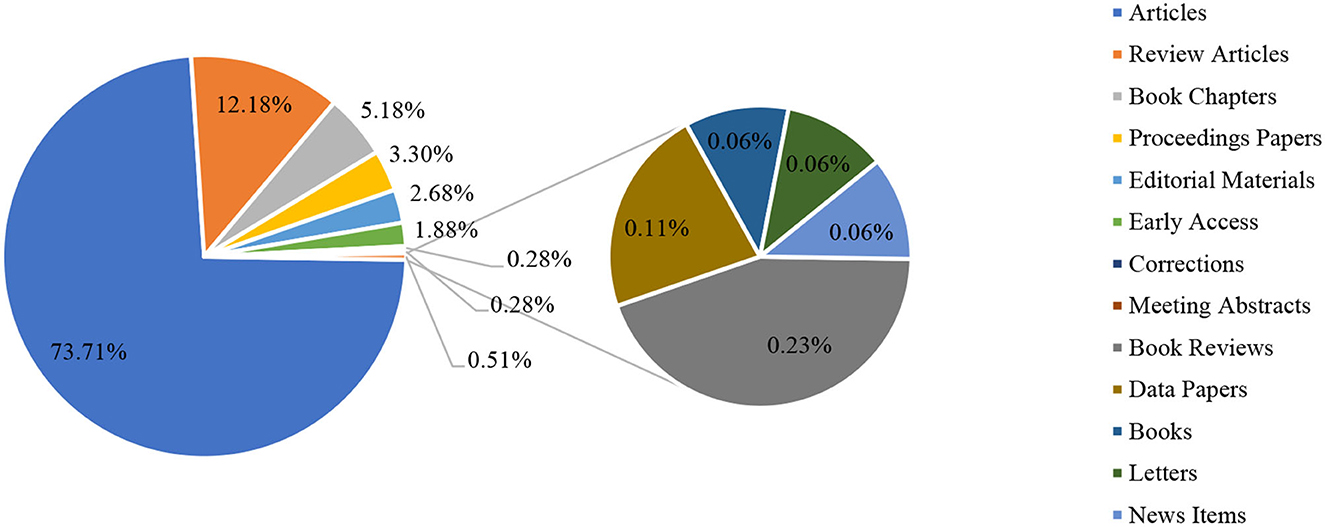
Figure 3. Document types of sustainable intensification research articles from 2010 to 20 August 2021.
3.2. Publication output and citation
The number of publications and the frequency of citations are used to determine the academic influence of the authors (Liang et al., 2018). Based on Sevinc (2004), citation analysis is one of the parameters used to assess the quality of research papers published in scientific, social sciences, and technology journals. The annual trend of research papers associated with SI from 2010 to 20 August 2021 is shown in Figure 4. From 2010 to 2021, 1,610 documents on the SI field were retrieved from the Web of Science Core Collection database. The first research papers related to SI were published in 1997 by Pretty, Bebbington, and Reardon et al. (Bebbington, 1997; Pretty, 1997; Reardon et al., 1997). The number of publications showed an exponential growth with less than 10 publications recorded in 2010. From 2010 to 2020, the number of publications increased by 97.61%, with the highest number of publications in 2020 (293 publications). The same trend regarding the number of citations per year was observed, as shown by an exponential growth trend in the annual citations and an increased number of citations from 2 in 2010 to 7903 by 20 August 2021, with the highest increase of 10,275 citations in 2020.
3.3. Annual publications per country
The annual publications from the top 10 most productive countries in the SI field are shown in Figure 5. The United States was the most productive country, with steady growth in research and a contribution of 22.42% during the study period (from 2010 to 20 August 2021). England ranked second with an annual increase in publications since 2014 and had the highest number of publications in 2011 and 2013, higher than the USA. Kenya was in the 5th position with a contribution of 139 publications (8.63%) and was the only African country in the top 10 countries between 2010 and 2021. It is worth noting that European countries like the Netherlands, Germany, and France together had the highest total contribution of 28.01% (451 publications).
3.4. Subject categories, research area, funding agencies, and organization analysis
The top 10 subject categories, research areas, funding agencies, and organizations in the SI field between 2010 and 20 August 2021 are shown in Table 1 below. All the 1,610 publications on studies related to the SI field are grouped according to 88 subject categories. Most of the publications analyzed in the present study are in “Environmental Science,” with 429 research papers, which account for 26.65% of the total publications. The second-ranking subject category is “Agronomy” with a contribution of 18.32% (295 publications), followed by “Agriculture Multidisciplinary” (281, 17.45%), “Green Sustainable Technology” (262, 16.27%), “Environmental Studies” (220, 13.67%), “Ecology” (143, 8.88%), etc. Other fields like “Agricultural economics policy,” and “Soil” each have < 100 documents. Research on SI is mostly published in the field of “Agriculture” (771 publications), followed by “Environmental Science Ecology” (555 publications), “Science Technology” (319 publications), “Food Science Technology” (120 publications), “Plant Science” (100 publications). The top funding agency and organization is the Consultative Group for International Agricultural Research (CGIAR), a global partnership involved in research dedicated to alleviating rural poverty, ensuring more sustainable management of natural resources, increasing food security, and improving human health and nutrition.
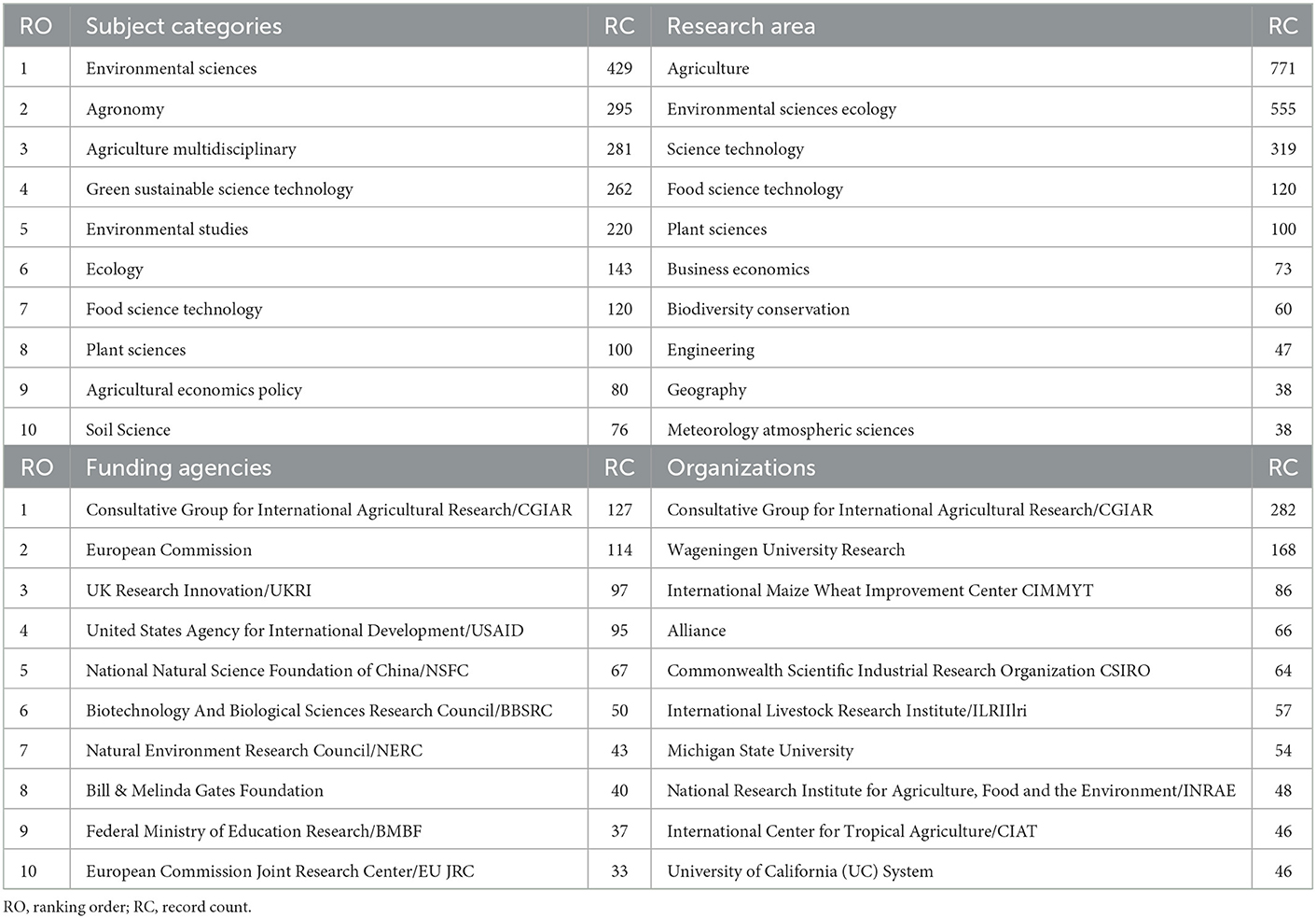
Table 1. Top 10 subject categories, research areas, funding agencies, and organizations in SI research from 2010 to 20 August 2021.
4. Global sustainable intensification of agriculture research
The importance of sustainable intensification (SI) research can be reflected by the distribution of publications in different countries, as shown in Figure 6. For instance, 115 countries were involved in SI research between 2010 and 20 August 2021. Of the top 10 most influential countries, there are four European countries (England, the Netherlands, Germany, and France), two American countries (the USA and Brazil), two Asian countries (China and India), and only one African country (Kenya). Moreover, Africa ranked second based on North and South America's overall contribution. In North and South America, there were four countries with more than 50 publications, while in Africa, there were three countries that had more than 50 publications.

Figure 6. Global literature on the topic of sustainable intensification from 2010 to 20 August 2021.
5. Collaboration analysis
5.1. Authors and collaborations
Out of 6,346 authors involved in the SI field, there are 119 authors with at least five co-authored publications grouped in 23 clusters differentiated by colors, with 288 links (i.e., the relationship between authors) and a total link strength (TLS) of 781 which denotes the cumulative strength of the links of a publication with other publications, as displayed by the network visualization map and density visualization in Figure 7. The co-authorship network shows the existence of co-authorship and the relation between authors of scientific research papers (Van Eck and Waltman, 2011). The nodes' size represents the author's research output, and the circles in the same color show the cluster the authors are associated with. The results showed that the maximum number of co-authored publications by each of the authors was 29. The top 5 and top 10 authors in Table 2 have contributed to 5.60 and 9.63% of the total publications. The first-ranked author Giller, K. E., from the Netherlands, co-authored 29 (1.80%) publications, followed by Jat, M. L., from India, and Pretty, J. from England, with a contribution of 17 (1.06%) and 15 (0.93%) publications. The most cited author was Pretty, J. with 1614 citations, followed by Giller, K.E. with 749 citations.
5.2. Countries and collaborations
The analysis of research output between countries is useful in identifying the most productive countries in SI research. The difference between the number of documents and citations by country is shown in Table 2. A total of 115 countries contributed to the research output of the SI field. Of the 115 countries, only 72 met a minimum number of five documents and were grouped in seven clusters that are differentiated by colorscolors with 1,065 links (i.e., the relationship between countries) and a total link strength (TLS) of 4,013, as displayed by the overlay visualization in Figure 8. The link strength was used as a quantitative index to show relations between two nodes (Pinto et al., 2014). The overlay visualization was used to show the earliest and most recent contributing countries in the SI field in terms of the average publication years. For instance, based on the overlay visualization, countries like Uruguay, Argentina, South Korea, Egypt, Chile, Hungary etc., have the most recent publications in the SI field. While countries like England, Malawi, Nigeria, Austria, Wales, Portugal etc., have the earliest publications. The USA was the most productive contributor to the SI research with 398 publications, and a TLS of 609. The second most productive country was England, with 262 publications and was the earliest contributor to the SI research, as seen in Figure 8. The same trend was observed with the number of citations, with the USA being the top country, with 16,773 citations followed by England with 8,997 citations. Of the 10 productive countries, 60% are developing countries, and 40% are developing countries like Kenya, China, Brazil, and India. Compared to the rest of the top 10 most productive countries, China, Brazil, and India had interacted with < 50 countries. Nodes represent the countries, and the size proportion is a function of publications. The lines that join the nodes show the existing interconnection between countries, i.e., it shows the collaboration's strength. The distance between two nodes or countries in the network visualization signifies topic relative strength and similarities, with stronger relations with the shorter distance. The Netherlands, France, and Kenya had close co-operations, showing some similarities in SI research.
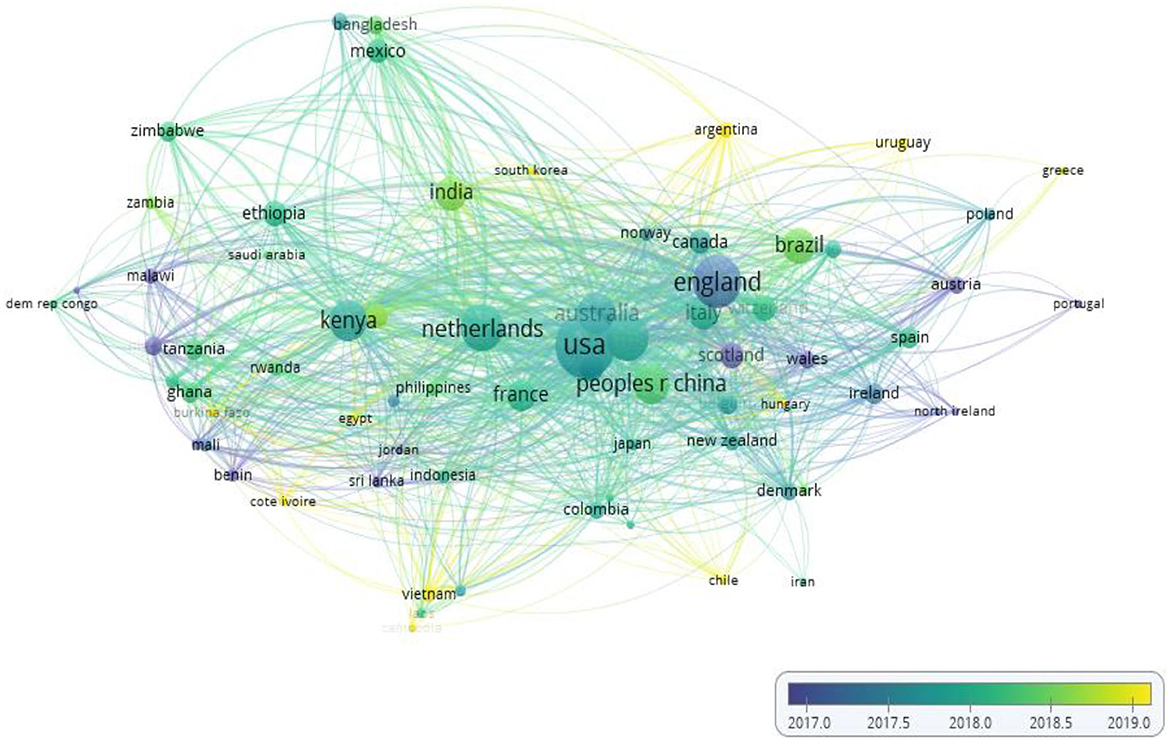
Figure 8. The overlay visualization of the country/region collaboration from 2010 to 20 August 2021.
6. Co-occurrence analysis
The co-occurrence analysis of keywords has proven to be an effective tool for monitoring and developing science and programs (Gao et al., 2017). Also, the analysis was used in the present study to evaluate the hot topics, including the research trends (Chen et al., 2016) and future potential topics (Ding and Yang, 2020) in the SI field and to reveal some neglected areas in the field (Koo, 2017). The density visualization was selected to understand the general structure and show the most imperative areas on the map (Chawla and Davis, 2013) (Figures 8, 9A). The top 20 co-occurrence keywords shown in Table 3 occurred in the abstract and title fields. In all the 3,876 authors' keywords and 6,526 all keywords retrieved from the database, only 216 and 611 keywords met a threshold of a minimum of five co-occurrence keywords. Figure 9A visualizes 10 different clusters, 2,303 links, and a total strength of 3,711 author keywords, while Figure 9B visualizes nine different clusters, 23,795 links, and 46,966 of all keywords. The size of the nodes shows the occurrence of the author and all keywords, and the larger the node in the network visualization is, the more a keyword has been co-selected in the SI field. The line joining the two nodes shows that the keywords appeared together, and the thicker the line, the co-occurrence they have (Gu et al., 2017).
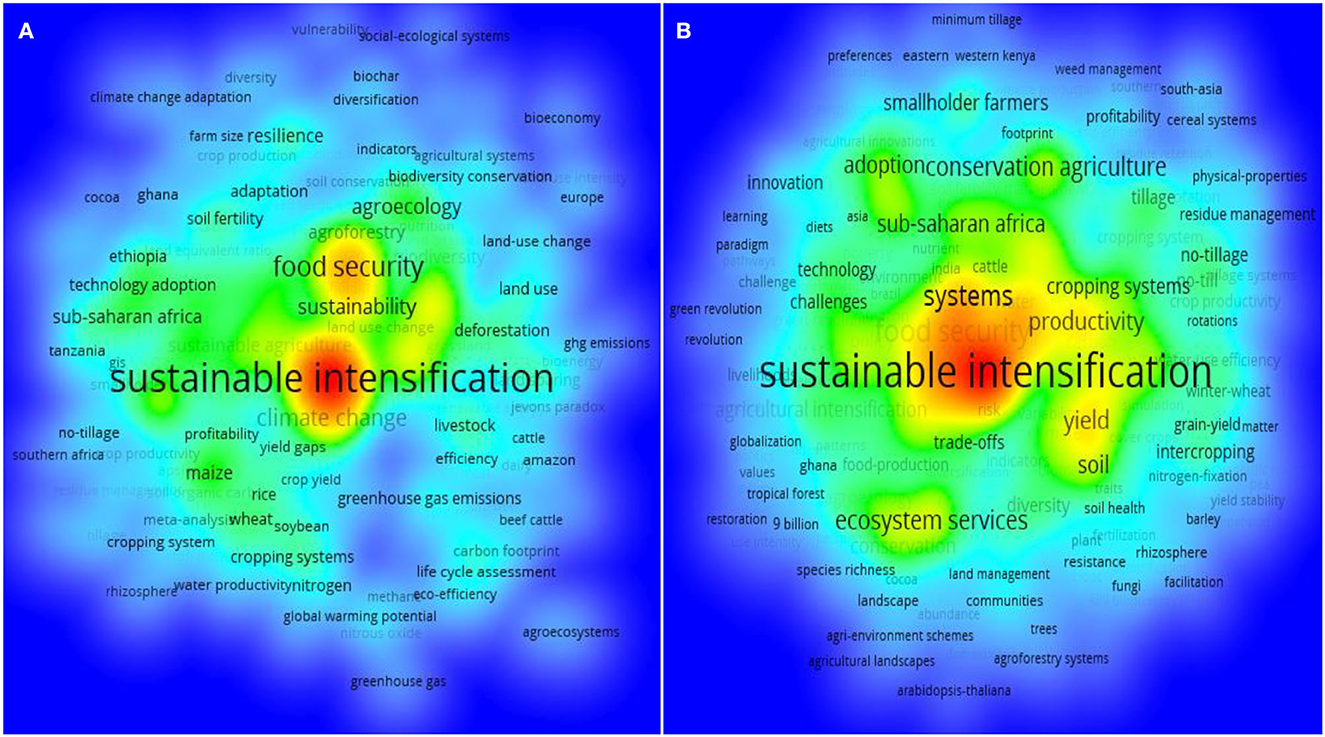
Figure 9. Author keywords (216) (A) and all keywords (611) network visualization (B) from 2010 to 20 August 2021.
7. Author and all keywords analysis
Apart from the first top keyword, which was the searching keyword (“Sustainable Intensification”) in the present study, the second-ranking keyword in both author and all keywords is “Food Security”, with 140 and 276 occurrences. Under author keywords, “Food Security” was followed by, “Agriculture” with 75, “Climate Change” with 75, “Sustainability” with 68, “Ecosystem Services” with 67, “Conservation Agriculture” with 54, “Agroecology” with 44, and “Sustainable Agriculture” with 43 occurrences, respectively. After “Sustainable Intensification” and “Food Security” in all keywords, “Management” (272), “Agriculture” (255), “Systems” (208), “Ecosystem services” (164), “Climate change” (158), “Conservation Agriculture” (145), “Productivity” (133), and “Yield” (133) was in the top 10 with more than 130 occurrences. It is worth noting that keywords like “Food Security”, “Climate Change”, “Agriculture”, “Ecosystem Services”, “Sustainability”, “Conservation Agriculture”, “Sub-Saharan Africa”, “Maize”, and “Intensification” appeared in both the top 20 author keywords and all keywords as shown in Table 3.
8. Co-authorship and organizations
Analysis of organizations involved in the SI field can assist in realizing the collaboration potential and capacity of organizations around the world, including the most productive organizations. The density visualization was selected to understand the most dominant organizations on the map (Figure 10B). Based on Chawla and Davis (2013), density visualization is used to understand the map's general structure and important areas. For instance, the map's red and yellow color shows the most dominant organizations. Wageningen University was the most productive organization, with 155 publications. Even with TLS of 419 (Table 4), Wageningen University was in the same cluster as CSIC, CSIR, the International Institute of Tropical Agriculture, and the University of Free State (Figure 10A), suggesting the dimension of similarity between the organizations. The second-ranking organization was the International Maize and Wheat Improvement Center (137), which was followed by the International Institute of Tropical Agriculture (69), Michigan State University (53), China Agricultural University (42), and the University of Minnesota with 34 publications. Even though the University of Minnesota was not among the top 6 most productive organizations in terms of publication output, the university had the highest number of citations (6,936) after Wageningen University. It is worth noting that out of 1,981 organizations involved in the SI field from 2010 to 2021, only 216 met a minimum of five publications and were grouped in 13 clusters.
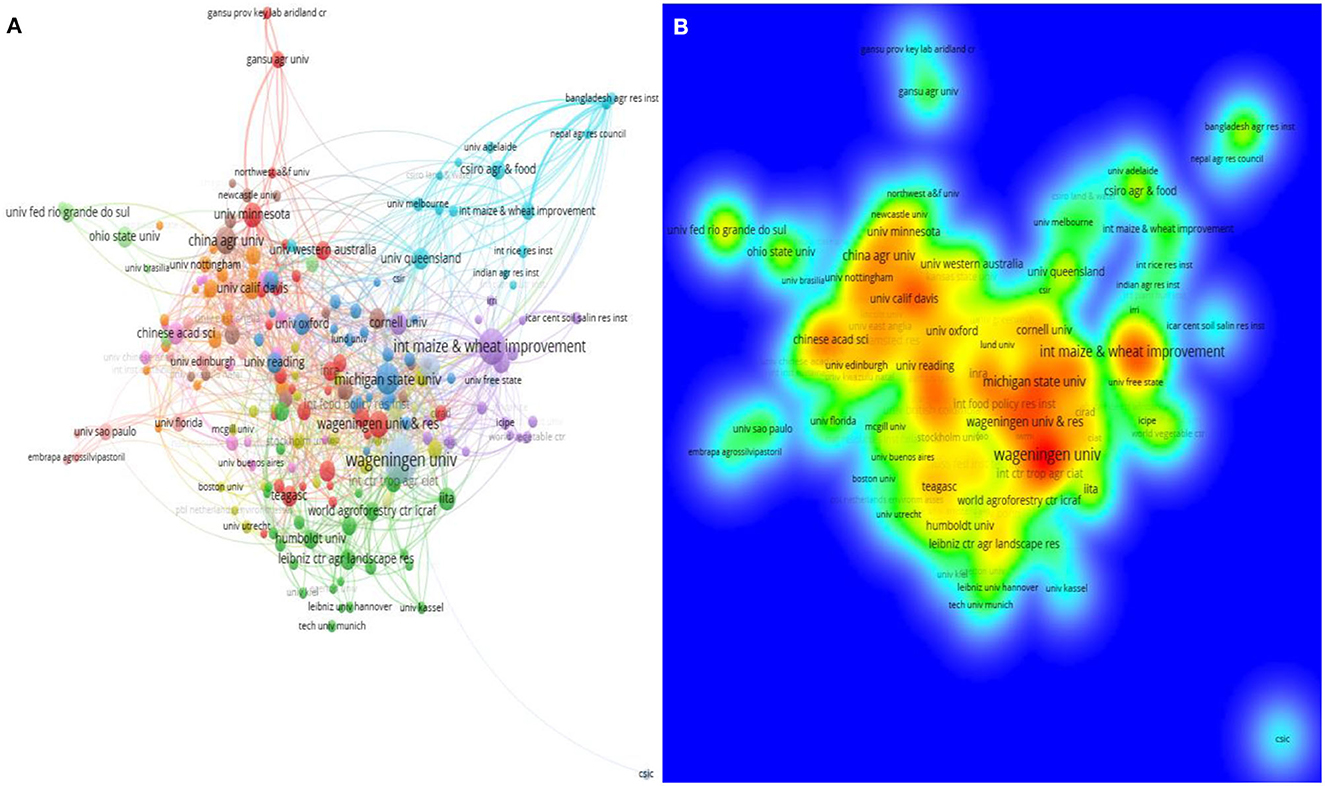
Figure 10. The network visualization (A), and density visualization (B) of co-authorship by the organization from 2010 to 20 August 2021.
9. Frequently cited documents
The literature highlighted that when the field of study is being evaluated, the citation obtained by the document should be considered, as it is necessary (Carrión-Mero et al., 2020). The papers involved in this research were cited 40 409 times, with an average citation of 25.1 per paper and an h-index of 85. Based on the h-index, which is used to measure the citation impact and the productivity of the publications, the h index of 85 indicates that 85 publications have more than 85 citations. The top 15 most cited publications in SI are shown in Table 5. The most cited publication with 2,952 citations, entitled “Global food demand and the SI of agriculture,” was published by Tilman et al. (2011) from the United States of America. In their study, the researchers promoted the adoption of Sustainable Agricultural Intensification. In the same study, the authors noted that the intensification of agriculture through transfer, improvement of soil fertility and technology adoption in poorer countries would greatly reduce yield gaps, provide a more equitable supply of food, greatly decrease greenhouse emissions and the extinction of species from land clearing. The second most cited paper published by Ray et al. (2013) is entitled “Yield Trends Are Insufficient to Double Global Crop Production by 2050,” with 1,235 citations. The authors identified areas where investment is needed to increase crop production and yield improvement and is on track to double crop production. The authors found that SI in Africa and elsewhere is necessary and possible to boost global crop production (Pretty et al., 2011; Mueller et al., 2012). The third most cited publication with 1,232 citations is “Closing yield gaps through nutrient and water management.” The co-authored paper was published in 2012 by Mueller et al. The authors investigated efforts required to increase yields on underperforming agricultural landscapes. The authors pointed out that one strategy for meeting food security and sustainability while decreasing agriculture's environmental global footprint is to increase resource use efficiency. The rest of the publications in the top 15 have < 1,000 citations (Table 5).
10. Discussion
The first three papers were published in 1997 by Pretty, Bebbington, and Reardon et al., under the topic “Social capital and rural intensification: local organizations and islands of sustainability in the rural Andes, “Promoting sustainable intensification and productivity growth in Sahel agriculture after macroeconomic policy reform,” and “The sustainable intensification of agriculture.” All three papers are connected to the promotion of SI, where there are existing opportunities for its adoption. However, an increase in the number of publications in 2011 shows that the inclusion of SI in agricultural and environmental policies was a success, and its adoption was gaining more recognition. For example, the first three most cited papers in the present study (Tilman et al., 2011; Mueller et al., 2012; Ray et al., 2013), each with more than 1,000 citations, agree that the SI of agriculture is required to meet the global food demands of 2050, rather than agricultural land clearing, and this includes studies by Garnett et al. (2013) and Vanlauwe et al. (2014). Also, a more recent study under the list of most cited articles (Table 5) by Rockström et al. (2017) suggests that sustainable transformation of agricultural systems is urgently and directly required to meet the Earth and World demands. The same authors are of the view that one strategy to be used “is the investment in spatially concentrated major grand experiments” where the knowledge from different domains, ranging from irrigated to rain fed agriculture, equity to business development, ecology and agronomy, work together to pilot SI at scale (e.g., in a region or basin), to pool experience, explore synergies and trade-offs, testing the hypothesis that SI can deliver livelihoods, food, and resilience while also contributing to development within Earth's safe operating space.”
The USA has contributed most to the SI research based on publications, followed by England. The highest number of publications in the US and European countries shows that publications on the topic are concentrated in developed countries, indicating that these developed countries play a crucial role in the SI of agriculture. The position of Kenya as the only African country in the top 10 can be explained by the availability of funding from CGIAR (45 publications), followed by the United States Agency for International Development/USAID (18 publications), European Commission (16 publications), Bill & Melinda Gates Foundation (10 publications) and Australian Centre for International Agricultural Research (six publications), and its association with the following organizations; GCIAR (102 publications; 64.96%); International Livestock Research Institute (42; 26.75%), Wageningen University Research (21.02%), World Agroforestry ICRAF (19.11%), and Alliance (29; 18.48%), respectively. Additionally, the earlier promotion of the SI field in Kenya after England, as shown in Figure 8, and the close interactions between Kenya and European countries like the Netherlands and France, can explain its position.
The use of overlay visualization to show the earliest and most recent publications has shown that the country with recent publications has the lowest number of publications, with fewer collaborations. A typical example is Uruguay, with 13 publications and 11 links. The lowest contribution can be attributed to the late adoption of SI in the country, where SI was included as one of the five strategic public policy approaches for 2015 to 2020 to achieve a sustainably intensified and Agro-Smart agricultural sector (World Bank; CIAT, 2015). The results show that SI is one of the important monasteries in European Agriculture. For instance, the highest contribution of the EU countries to SI research is likely due to the decision made by the EU to push for SI in European agriculture without degrading the environment (Fischler and Pirzio-Biroli, 2014).
Additionally, the urge to move toward SI might be because most of the existing intensively farmed land in Europe is not managed sustainably, as noted by Buckwell et al. (2014). From the study by Schiefer et al. (2016) entitled “potential and limits of land and soil for SI of European agriculture,” the suitability and the potential of land and soil for SI were explained after the area of arable land was analyzed by FAO Stat-Agricultural area in 2015. In their study, some European union member countries with very low contributions in the SI field, like Slovakia, Slovenia, and Hungary, were included. From their findings and recommendations, after Luxembourg and Belgium, the soil in Slovakia has high resilience and is suitable and recommended for SI. For instance, of the 96% area of arable land (13,376 km2) analyzed, 76.9% is highly resilient and recommended for SI. In the case of Hungary and Slovenia, of the 94% (40,657 km2) and 25% (433 km2) area of arable land analyzed, 62.3 and 34.2% were highly soil resilient and recommended for SI. Therefore, researchers should take advantage of these soils by adopting more sustainable ways of farming, especially in countries like Hungary, where there is potential for corn production and where corn production is vulnerable in the long run (Marton et al., 2020). Also, both fertilizers and pesticides in highly resilient soils can be transformed into performance, while their application in low resilient soils usually leads to environmental pollution (e.g., groundwater). Based on Blum (1994), soil resilience is the capacity of a system to return to a new equilibrium after disturbance, and it defines the arable land's potential sustainable agricultural production and, consequently, the limits for SI (Buckwell et al., 2014).
The occurrence of agro-ecology in author keywords can be linked to the fact that agro-ecology is presented as a component of SI and CSA [Global Alliance for Climate-Smart Agriculture (GACSA), 2014], even though it is in other countries' aspects different from CSA. In a research paper published by Sahu et al. (2020) under the topic “Climate-Smart Agriculture: A new approach for sustainable intensification,” the authors stated that CSA and SI are complementary and play a significant role in fighting global warming, nutrition, and food security. Therefore, the global adoption of CSA and SI practices is crucial for meeting global food demand that is projected to increase in the face of climate change and environmental land degradation. Out of thousands of crops available globally, “maize” as a grain crop occurred in both author and all keywords (Table 3) as the widely grown crop, especially by smallholder African countries as a staple crop. From the top 10 list of most productive co-authors, three authors are working for the International Maize and Wheat Improvement Center (CIMMYT), including Jat, M. L, Baudron Frederic Thierfelder Christian. For instance, Jat ML from India leads CIMMYT's climate-smart agriculture research portfolio in South Asia as part of CGIAR, regularly coordinating and providing strategic support to CIMMTY's sustainable intensification efforts to mobilize resources for scaling SI and CSA in wheat and maize systems. These authors are based in developing countries like India, Zimbabwe, which shows that SI is key to agricultural development in Asia and Africa.
On the other hand, the occurrence of other keywords like “food security,” “climate change,” “agriculture,” “ecosystem services,” “conservation agriculture,” “Sub-Sahara Africa,” “Africa,” and “Biodiversity” in both author and all keywords reveals the significance of sustainable intensification (SI) in African Agriculture, in the face of climate change and food insecurity, and the promotion of biodiversity after its adoption by the farmers. The number of publications produced should also analyze the importance of SI in African countries, and currently, only a few African countries have contributed to the field, even though the term SI was initially used in the context of African smallholder agriculture in the mid-1990s (Pretty, 1997; Garnett and Godfray, 2012), with farmers as research objects and their behavior choices in the practice of SI (Kassie et al., 2015; David et al., 2016). Sub-Saharan countries like South Africa, Ethiopia, Tanzania, Ghana, and Zimbabwe were among the top 30 countries in the SI research, contributing 18.82% (303 publications). In Sub-Sahara Africa, about 24% of the land area is affected by land degradation, with an estimated economic loss of about 68 billion dollars per annum and about 180 million people. While 12% of South Africa's landmass is suitable for arable production, only 3% of the land is genuinely fertile.
Nevertheless, despite the great potential of SI practices in Africa, further work to support improved extension messages and consider the wide range of practices needed for sustainable, integrated crop management is required. Also, for African smallholders, agricultural intensification, whether ecological, sustainable, or conventional, is simply a necessity (Tittonell and Giller, 2013). However, the implementation of SI is complicated by temporal delays in yield increase and positive returns, including limited supportive policy frameworks for sustainable agriculture, as reported by Pretty (2008) and Petersen and Snapp (2015).
11. Conclusions
Most contribution mainly focuses on sustainable agricultural practices which are designed to promote food security in Sub-Saharan African countries. Even though the focus was on African countries, the contribution from African scholars was significantly lower. With Kenya being the most contributing country in Africa, funding and research opportunities throughout Africa can help promote food security in the region. Opportunities for more sustainable agricultural practices are not restricted to Sub-Saharan and African nations, where food security and nutrition are threatened by the vulnerability of farmers to the effects of climate change, but also exist in European nations such as Slovakia and Hungary, where sustainable intensification (SI) has been recommended due to the high soil resilience of arable land.
Data availability statement
The original contributions presented in the study are included in the article/supplementary material, further inquiries can be directed to the corresponding author.
Author contributions
Conceptualization: SA and CB. Methodology, formal analysis, investigation, resources, writing—original draft preparation, and visualization: SA. Validation and writing—review and editing: SA, CB, BS, and MG. All authors contributed to the article and approved the submitted version.
Conflict of interest
The authors declare that the research was conducted in the absence of any commercial or financial relationships that could be construed as a potential conflict of interest.
Publisher's note
All claims expressed in this article are solely those of the authors and do not necessarily represent those of their affiliated organizations, or those of the publisher, the editors and the reviewers. Any product that may be evaluated in this article, or claim that may be made by its manufacturer, is not guaranteed or endorsed by the publisher.
References
Ajibade, S. (2020). The Potential of Sustainable Agriculture on Agricultural Development: A Case of uMgungundlovu District Municipality, KwaZulu-Natal Province, South Africa [MSc Thesis]. Godollo: Hungarian University of Agriculture and Life Sciences-former Szent Istvan University.
Altieri, M. A., Funes-Monzote, F. R., and Petersen, P. (2012). Agroecologically efficient agricultural systems for smallholder farmers: contributions to food sovereignty. Agron. Sustain. Dev. 32, 1–13. doi: 10.1007/s13593-011-0065-6
BajŽelj, B., Richards, K. S., Allwood, J. M., Smith, P., Dennis, J. S., Curmi, E., et al. (2014). Importance of food-demand management for climate mitigation. Nat. Clim. Chang. 4, 924–929. doi: 10.1038/nclimate2353
Bebbington, A. (1997). Social capital and rural intensification: local organizations and islands of sustainability in the rural Andes. Geogr. J. 163, 189–197. doi: 10.2307/3060182
Bello-Schünemann, J., Cilliers, J., Donnenfeld, Z., Aucoin, C., and Porter, A. (2017). African Futures—Key Trends to 2035. Pretoria: Institute for Security Studies. Policy brief. doi: 10.2139/ssrn.3099362
Blum, W. E. H. (1994). A Concept of Sustainability and Resilience Based on Soil Functions: The Role of the ISSS in Promoting Sustainable Land Use. Vienna: Institut fur Bodenforschung, Universitat fur Bodenkultur.
Brooker, R. W., Bennett, A. E., Cong, W. F., Daniell, T. J., George, T. S., Hallett, P. D., et al. (2015). Improving intercropping: a synthesis of research in agronomy, plant physiology and ecology. New Phytol. 206, 107–117. doi: 10.1111/nph.13132
Buckwell, A., Uhre, A. N., Williams, A., Blum, W. E. H., Schiefer, J., Lair, G. J., et al. (2014). Sustainable Intensification of European agriculture- A Review Sponsored by the RISE Foundation. Brussels.
Campbell, B. M., Thornton, P., Zougmoré, R., Van Asten, P., and Lipper, L. (2014). Sustainable intensification: what is its role in climate smart agriculture? Curr. Opin. Environ. Sustain. 8, 39–43. doi: 10.1016/j.cosust.2014.07.002
Carrión-Mero, P., Montalván-Burbano, N., Paz-Salas, N., and Morante-Carballo, F. (2020). Volcanic geomorphology: a review of worldwide research. Geosciences 10, 347. doi: 10.3390/geosciences10090347
Chawla, N. V., and Davis, D. A. (2013). Bringing big data to personalized healthcare: a patient-centered framework. J. Gen. Intern. Med. 28, 660–665. doi: 10.1007/s11606-013-2455-8
Chen, D., Liu, Z., Luo, Z., Webber, M., and Chen, J. (2016). Bibliometric and visualized analysis of energy research. Ecol. Eng. 90, 285–293. doi: 10.1016/j.ecoleng.2016.01.026
Comprehensive Assessment of Water Management in Agriculture (2007). in Water for Food, Water for Life: A Comprehensive Assessment of Water Management in Agriculture, ed. D. Molden. London: Earthscan, and Colombo: International Water Management Institute. doi: 10.4324/9781849773799
DAFF (Department of Agriculture Forestry and Fisheries). (2014). “Agricultural Policy Action Plan 2014–19”. Pretoria: DAFF.
David, L. O., Kurt, B. W., and Robert, B. R. (2016). Sustainable intensification and farmer preferences for crop system attributes: evidence from Malawi's Central and Southern Regions. World Dev. 87, 139–151. doi: 10.1016/j.worlddev.2016.06.007
De Bakker, F. G. A., Groenewegen, P., and Den Hond, F. (2016). A bibliometric analysis of 30 years of research and theory on corporate social responsibility and corporate social performance. Bus. Soc. 44, 283–317. doi: 10.1177/0007650305278086
Ding, X., and Yang, Z. (2020). Knowledge mapping of platform research: a visual analysis using VOSviewer and CiteSpace. Electron. Commer. Res. 22, 1–23. doi: 10.1007/s10660-020-09410-7
Fischer, J., Abson, D. J., Butsic, V., Chappell, M. J., Ekroos, J., Hanspach, J., et al. (2014). Land sparing versus land sharing: moving forward. Conserv. Lett. 7, 149–157. doi: 10.1111/conl.12084
Fischler, F., and Pirzio-Biroli, C. (2014). EU Urged to Push for ‘Sustainable Intensification' of European Agriculture. Available online at: https://www.theparliamentmagazine.eu/news/article/eu-urged-to-push-for-sustainable-intensification-of-european-agriculture (accessed October 5, 2022).
Gao, Y., Wang, Y., Zhai, X., He, Y., Chen, R., Zhou, J., et al. (2017). Publication trends of research on diabetes mellitus and T cells (1997–2016): a 20-year bibliometric study. PLoS ONE 12, e0184869. doi: 10.1371/journal.pone.0184869
Garnett, T., Appleby, M. C., Balmford, A., Bateman, I. J., Benton, T. G., Bloomer, P., et al. (2013). Sustainable intensification in agriculture: premises and policies. Science 341, 33–34. doi: 10.1126/science.1234485
Garnett, T., and Godfray, C. (2012). “Sustainable intensification in agriculture. Navigating a course through competing food system priorities,” in Food Climate Research Network and the Oxford Martin Programprogram on the Future of Food. Oxford: University of Oxford, 51.
Giller, K. E., Andersson, J. A., Corbeels, M., Kirkegaard, J., Mortensen, D., Erenstein, O., et al. (2015). Beyond conservation agriculture. Front. Plant Sci. 6, 870. doi: 10.3389/fpls.2015.00870
Global Alliance for Climate-Smart Agriculture (GACSA) (2014). Framework Document. Available online at: http://www.fao.org/gacsa/en/ (accessed July 2, 2021).
Godfray, H. C. J., Beddington, J. R., Crute, I. R., Haddad, L., Lawrence, D., Muir, J. F., et al. (2010). Food security: the challenge of feeding 9 billion people. Science 327, 812–818. doi: 10.1126/science.1185383
Godfray, H. C. J., and Garnett, T. (2014). Food security and sustainable intensification. Philos. Trans. R Soc. Lond. B Biol. Sci. 369, 20120273. doi: 10.1098/rstb.2012.0273
Gu, D., Li, J., Li, X., and Liang, C. (2017). Visualizing the knowledge structure and evolution of big data research in healthcare informatics. Int. J. Med. Inform. 98, 22–32. doi: 10.1016/j.ijmedinf.2016.11.006
Hirsch, J. E. (2005). An index to quantify an individual's scientific research output. Proc. Nat. Acad. Sci. 102, 16569–16572. doi: 10.1073/pnas.0507655102
Hutchinson, J., and Tarasuk, V. (2022). The relationship between diet quality and the severity of household food insecurity in Canada. Public Health Nutr. 25, 1013–1026. doi: 10.1017/S1368980021004031
IPCC (2007). “Summary for policymakers,” in Climate Change 2007: The Physical Science Basis. Contribution of Working Group I to the Fourth Assessment Report of the Intergovernmental Panel on Climate Change, eds S. Solomon, D. Qin, M. Manning, Z. Chen, M. Marquis, K. B. Averyt, et al. (Cambridge: Cambridge University Press).
Kaczan, D., Arslan, A., and Lipper, L. (2013). Climate-smart Agriculture? A Review of Current Practice of Agroforestry and Conservation Agriculture in Malawi and Zambia. FAO; Durham: Duke University
Kassie, M., Teklewold, H., Jaleta, M., Marenya, P., and Erenstein, O. (2015). Understanding the adoption of a portfolio of sustainable intensification practices in eastern and southern Africa. Land Use Policy 42, 400–411. doi: 10.1016/j.landusepol.2014.08.016
Koo, M. (2017). A bibliometric analysis of two decades of aromatherapy research. BMC Res. Notes 10, 1–9. doi: 10.1186/s13104-016-2371-1
Li, D., Zhao, R., Peng, X., Ma, Z., Zhao, Y., Gong, T., et al. (2020). Biochar-related studies from 1999 to 2018: a bibliometrics-based review. Environ. Sci. Pollut. Res. 27, 2898–2908. doi: 10.1007/s11356-019-06870-9
Liang, C., Luo, A., and Zhong, Z. (2018). Knowledge mapping of medication literacy study: a visualized analysis using CiteSpace. SAGE Open Med. 6, 2050312118800199. doi: 10.1177/2050312118800199
Linquist, B., Van Groenigen, K. J., Adviento-Borbe, M. A., Pittelkow, C., and Van Kessel, C. (2012). An agronomic assessment of greenhouse gas emissions from major cereal crops. Glob. Chang. Biol. 18, 194–209. doi: 10.1111/j.1365-2486.2011.02502.x
Marton, T. A., Kis, A., Zubor-Nemes, A., Kern, A., and Fodor, N. (2020). Human impact promotes sustainable corn production in Hungary. Sustainability 12, 6784. doi: 10.3390/su12176784
Mbow, C., Rosenzweig, C., Barioni, L. G., Benton, T. G., Herrero, M., Krishnapillai, M., et al. (2019). “Food security,” in Climate Change and Land: An IPCC Special Report on Climate Change, Desertication, Land Degradation, Sustainable Land Management, Food Security, and Greenhouse Gas Uxes Interrestrial Ecosystems, eds P. R Shukla, J. Skea, E. Calvo Buendia, V. Masson-Delmotte, H.-O. Pörtner, and D. C. Roberts, 437–550. doi: 10.1017/9781009157988.007
Merigó, J. M., and Yang, J. B. (2017). A bibliometric analysis of operations research and management science. Omega 73, 37–48. doi: 10.1016/j.omega.2016.12.004
Mora, L., Bolici, R., and Deakin, M. (2017). The first two decades of smart-city research: a bibliometric analysis. J. Urban Technol. 24, 3–27. doi: 10.1080/10630732.2017.1285123
Mueller, N. D., Gerber, J. S., Johnston, M., Ray, D. K., Ramankutty, N., Foley, J. A., et al. (2012). Closing yield gaps through nutrient and water management. Nature 490, 254–257. doi: 10.1038/nature11420
Nciizah, A. D., Mupambwa, H. A., Nyambo, P., and Muchara, B. (2022). “From soil to fork: can sustainable intensification guarantee food security for smallholder farmers?,” in Food Security for African Smallholder Farmers (Singapore: Springer Nature Singapore), 27–46. doi: 10.1007/978-981-16-6771-8_2
Ngcamu, B. S., and Chari, F. (2020). Drought influences on food insecurity in Africa: a systematic literature review. Int. J. Environ. Res. Public Health 17, 5897. doi: 10.3390/ijerph17165897
Nkwana, H. M. (2015). The Implementation of the National Food and Nutrition Security Policy in South Africa: Strategies for Multisectoral Coordination. Pretoria.
Nobanee, H., Al Hamadi, F. Y., Abdulaziz, F. A., Abukarsh, L. S., Alqahtani, A. F., AlSubaey, S. K., et al. (2021). A bibliometric analysis of sustainability and risk management. Sustainability 13, 3277. doi: 10.3390/su13063277
Ojo, T., Ruan, C., Hameed, T., Malburg, C., Thunga, S., Smith, J., et al. (2022). HIV, tuberculosis, and food insecurity in Africa—a syndemics-based scoping review. Int. J. Environ. Res. Public Health 19, 1101. doi: 10.3390/ijerph19031101
Okem, A. E. (2015). Achieving the Comprehensive Africa Agricultural Development Programme's goal of food security: what roles can cooperatives play? J. Afr. Union Stud. 4, 69–95.
Petersen, B., and Snapp, S. (2015). What is sustainable intensification? Views from experts. Land Use Policy 46, 1–10. doi: 10.1016/j.landusepol.2015.02.002
Phalan, B., Balmford, A., Green, R. E., and Scharlemann, J. P. (2011). Minimizing the harm to biodiversity of producing more food globally. Food Policy 36, S62–S71. doi: 10.1016/j.foodpol.2010.11.008
Pinto, M., Pulgarín, A., and Escalona, M. I. (2014). Viewing information literacy concepts: a comparison of two branches of knowledge. Scientometrics 98, 2311–2329. doi: 10.1007/s11192-013-1166-6
Pittelkow, C. M., Liang, X., Linquist, B. A., Van Groenigen, K. J., Lee, J., Lundy, M. E., et al. (2015). Productivity limits and potentials of the principles of conservation agriculture. Nature 517, 365–368. doi: 10.1038/nature13809
Place, F., Barrett, C. B., Freeman, H. A., Ramisch, J. J., and Vanlauwe, B. (2003). Prospects for integrated soil fertility management using organic and inorganic inputs: evidence from smallholder African agricultural systems. Food Policy 28, 365–378. doi: 10.1016/j.foodpol.2003.08.009
Pretty, J. (2008). Agricultural sustainability: concepts, principles and evidence. Philos. Trans. R Soc. Lond. B Biol. Sci. 363, 447–465. doi: 10.1098/rstb.2007.2163
Pretty, J., Benton, T. G., Bharucha, Z. P., Dicks, L. V., Butler Flora, C., Godfray, H. C. J., et al. (2018). Global assessment of agricultural system redesign for sustainable intensication. Nat Sustain 1, 441–446. doi: 10.1038/s41893-018-0114-0
Pretty, J., and Bharucha, Z. P. (2014). Sustainable intensification in agricultural systems. Ann. Bot. 114, 1571–1596. doi: 10.1093/aob/mcu205
Pretty, J., Toulmin, C., and Williams, S. (2011). Sustainable intensification in African agriculture. Int. J. Agric. Sustain. 9, 5–24. doi: 10.3763/ijas.2010.0583
Pretty, J. N. (1997). “Sustainable intensification of agriculture,” in Natural Resources Forum, Vol. 21. Oxford, UK: Blackwell Publishing Ltd, 247–256. doi: 10.1111/j.1477-8947.1997.tb00699.x
Ramankutty, N., Evan, A. T., Monfreda, C., and Foley, J. A. (2008). Farming the planet: 1. Geographic distribution of global agricultural lands in the year 2000. Glob Biogeochem. Cycles 22. doi: 10.1029/2007gb002952
Ray, D. K., Mueller, N. D., West, P. C., and Foley, J. A. (2013). Yield trends are insufficient to double global crop production by 2050. PLoS ONE 8, e66428. doi: 10.1371/journal.pone.0066428
Rayner, J., and Howlett, M. (2009). Introduction: understanding integrated policy strategies and their evolution. Policy Soc. 28, 99–109. doi: 10.1016/j.polsoc.2009.05.001
Reardon, T., Kelly, V., Crawford, E., Diagana, B., Dioné, J., Savadogo, K., et al. (1997). Promoting sustainable intensification and productivity growth in Sahel agriculture after macroeconomic policy reform. Food Policy 22, 317–327. doi: 10.1016/S0306-9192(97)00022-5
Reij, C., Tappan, G., and Smale, M. (2009). Agroenvironmental Transformation in the Sahel: Another Kind of “Green Revolution''. Washington, DC: International Food Policy Research Institute (IFPRI), IFPRI discussion paper 00914, 43.
Rockström, J., Williams, J., Daily, G., Noble, A., Matthews, N., Gordon, L., et al. (2017). Sustainable intensification of agriculture for human prosperity and global sustainability. Ambio 46, 4–17. doi: 10.1007/s13280-016-0793-6
Rusinamhodzi, L., Corbeels, M., van Wijk, M. T., Runo, M. C., Nyamangara, J., Giller, K. E., et al. (2011). A metaanalysis of long-term effects of conservation agriculture on maize grain yield under rain-fed conditions. Agron. Sustain. Dev. 31, 657–673. doi: 10.1007/s13593-011-0040-2
Sahu, G., Rout, P. P., Mohapatra, S., Das, S. P., and Pradhan, P. P. (2020). Climate smart agriculture: a new approach for sustainable intensification. Curr J. Appl. Sci. Technol. 138–147. doi: 10.9734/cjast/2020/v39i2330862
Schiefer, J., Lair, G. J., and Blum, W. E. (2016). Potential and limits of land and soil for sustainable Intensification of European agriculture. Agric. Ecosyst. Environ. 230, 283–293. doi: 10.1016/j.agee.2016.06.021
Sevinc, A. (2004). Web of science: a unique method of cited reference searching. J. Natl. Med. Assoc. 96, 980.
Shi, P., Zhang, T., Liu, Z., Lan, J., and Fan, X. (2019). A vulnerable environment study in karst regions between 1991 and 2017: a bibliometric analysis. Appl. Sci. 9, 5339. doi: 10.3390/app9245339
Smith, A., Snapp, S., Chikowo, R., Thorne, P., Bekunda, M., Glover, J., et al. (2017). Measuring sustainable intensification in smallholder agroecosystems: a review. Glob. Food Secur. 12, 127–138. doi: 10.1016/j.gfs.2016.11.002
Smith, P., House, J. I., Bustamante, M., Sobock,á, J., Harper, R., Pan, G., et al. (2016). Global change pressures on soils from land use and management. Glob. Chang. Biol. 22, 1008–1028. doi: 10.1111/gcb.13068
Sullivan, A., Mwamakamba, S. N., Mumba, A., Hachigonta, S., and Sibanda, L. M. (2012). Climate Smart Agriculture: More than Technologies are Needed to Move Smallholder Farmers Toward Resilient and Sustainable Livelihoods. Pretoria.
Sweileh, W. M., Al-Jabi, S. W., Sawalha, A. F., AbuTaha, A. S., and Sa'ed, H. Z. (2016). Bibliometric analysis of publications on Campylobacter: (2000–2015). J. Health Popul. Nutr. 35,39. doi: 10.1186/s41043-016-0076-7
Thierfelder, C., and Wall, P. C. (2012). Effects of conservation agriculture on soil quality and productivity in contrasting agro-ecological environments of Zimbabwe. Soil Use Manag. 28, 209–220. doi: 10.1111/j.1475-2743.2012.00406.x
Tilman, D., Balzer, C., Hill, J., and Befort, B. L. (2011). Global food demand and the sustainable intensification of agriculture. Proc. Nat. Acad. Sci. 108, 20260–20264. doi: 10.1073/pnas.1116437108
Tittonell, P. (2014). Ecological intensification of agriculture—sustainable by nature. Curr. Opin. Environ. Sustain. 8, 53–61. doi: 10.1016/j.cosust.2014.08.006
Tittonell, P., and Giller, K. E. (2013). When yield gaps are poverty traps: the paradigm of ecological intensification in African smallholder agriculture. Field Crops Res. 143, 76–90. doi: 10.1016/j.fcr.2012.10.007
Tully, K., Sullivan, C., Weil, R., and Sanchez, P. (2015). The state of soil degradation in sub-Saharan Africa: baselines, trajectories, and solutions. Sustainability 7, 1–30. doi: 10.3390/su7066523
Van Eck, N. J., and Waltman, L. (2010). Software survey: VOSviewer, a computer program for bibliometric mapping. Scientometrics 84, 523–538. doi: 10.1007/s11192-009-0146-3
Van Eck, N. J., and Waltman, L. (2011). Text mining and visualization using VOSviewer. arXiv [preprint]. Available online at: https://arxiv.org/ftp/arxiv/papers/1109/1109.2058.pdf
Van Ittersum, M. K., Cassman, K. G., Grassini, P., Wolf, J., Tittonell, P., Hochman, Z., et al. (2013). Yield gap analysis with local to global relevance—a review. Field Crops Res. 143, 4–17. doi: 10.1016/j.fcr.2012.09.009
Vanlauwe, B., Coyne, D., Gockowski, J., Hauser, S., Huising, J., Masso, C., et al. (2014). Sustainable intensification and the African smallholder farmer. Curr. Opin. Environ. Sustain. 8, 15–22. doi: 10.1016/j.cosust.2014.06.001
Wang, J., and Wang, S. (2019). Preparation, modification and environmental application of biochar: a review. J. Clean. Prod. 227, 1002–1022. doi: 10.1016/j.jclepro.2019.04.282
World Bank; CIAT (2015). Climate-smart agriculture in Uruguay. CSA Country Profiles for Africa, Asia, and Latin America and the Caribbean Series. Washington DC: The World Bank Group.
Xia, S., and Zhong, K. (2021). Knowledge mapping of green technology visualization with bibliometric tools. Sci. Program. 2021, 6298813. doi: 10.1155/2021/6298813
Xie, H., Huang, Y., Chen, Q., Zhang, Y., and Wu, Q. (2019). Prospects for agricultural sustainable intensication: a review of research. Land 8, 157. doi: 10.3390/land8110157
Yeung, A. W. K., Goto, T. K., and Leung, W. K. (2017). A bibliometric review of research trends in neuroimaging. Curr. Sci. 725–734. doi: 10.18520/cs/v112/i04/725-734
Yu, D., and Liao, H. (2016). Visualization and quantitative research on intuitionistic fuzzy studies. J. Intell. Fuzzy Syst. 30, 3653–3663. doi: 10.3233/IFS-162111
Keywords: sustainable intensification, food security, climate change, climate-smart agriculture, agriculture
Citation: Ajibade S, Simon B, Gulyas M and Balint C (2023) Sustainable intensification of agriculture as a tool to promote food security: A bibliometric analysis. Front. Sustain. Food Syst. 7:1101528. doi: 10.3389/fsufs.2023.1101528
Received: 17 November 2022; Accepted: 23 January 2023;
Published: 13 February 2023.
Edited by:
Gopal Shukla, Uttar Banga Krishi Viswavidyalaya, IndiaReviewed by:
Apurbo Sarkar, The University of Queensland, AustraliaPradip Kumar Sarkar, Indian Council of Agricultural Research (ICAR), India
Copyright © 2023 Ajibade, Simon, Gulyas and Balint. This is an open-access article distributed under the terms of the Creative Commons Attribution License (CC BY). The use, distribution or reproduction in other forums is permitted, provided the original author(s) and the copyright owner(s) are credited and that the original publication in this journal is cited, in accordance with accepted academic practice. No use, distribution or reproduction is permitted which does not comply with these terms.
*Correspondence: Sinazo Ajibade,  c2luYXpvYWppYmFkZUBnbWFpbC5jb20=;
c2luYXpvYWppYmFkZUBnbWFpbC5jb20=;  amFjb2Jzc2luYXpvQGdtYWlsLmNvbQ==
amFjb2Jzc2luYXpvQGdtYWlsLmNvbQ==
†ORCID: Sinazo Ajibade orcid.org/0000-0001-8727-5696
Barbara Simon orcid.org/0000-0002-1343-8154
Miklos Gulyas orcid.org/0000-0002-1910-0867
Csaba Balint orcid.org/0000-0001-6085-0056
 Sinazo Ajibade
Sinazo Ajibade Barbara Simon
Barbara Simon Miklos Gulyas
Miklos Gulyas Csaba Balint
Csaba Balint